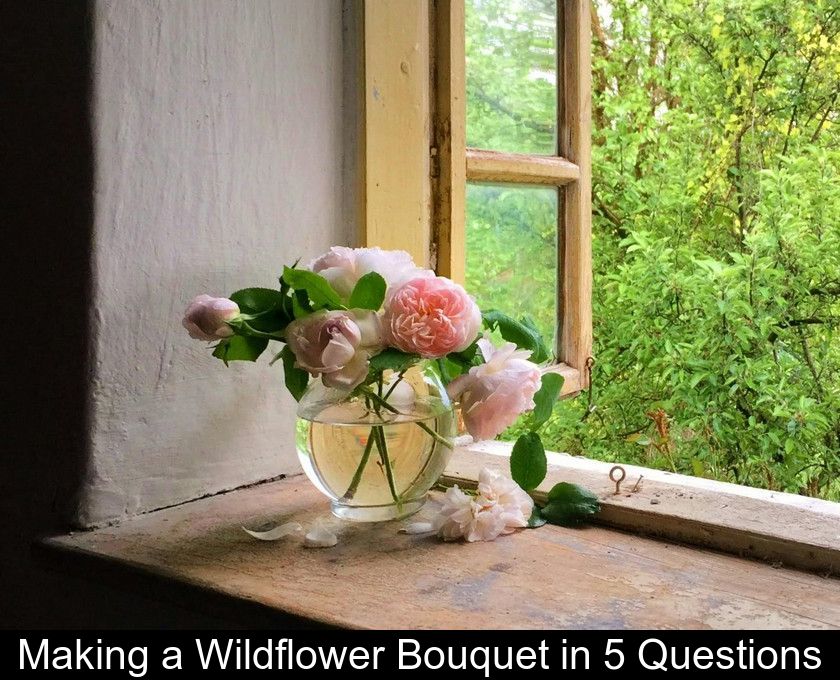Making A Wildflower Bouquet In 5 Questions
Composed of flowers picked from nature or the garden, wildflower bouquets owe their charm to their natural and spontaneous appearance. However, there are a few rules and tips to know in order to create a chic and harmonious floral arrangement. We will explain how to make a wildflower bouquet in 5 questions.
1- What is a rustic bouquet?
As its name suggests, a rustic bouquet consists of flowers that grow naturally in the countryside. It is recognized by its wild and authentic appearance and its apparent simplicity.
In recent years, this type of natural bouquet has become very popular in wedding decoration: even the bride's bouquet has become more asymmetrical and unstructured than the traditional florist's bouquet!
Summer is the best season to create this type of bouquet, provided you get up early. It is at dawn that you can pick the most beautiful flowers in the fields and on the sides of roads or hiking trails.
2- Which flowers to choose for a rustic bouquet?
To make a rustic bouquet, you will be spoiled for choice among the many wild or cultivated plants that bloom from spring to early summer.
In France, some rustic bouquets are composed of cornflowers, daisies, and poppies to replicate the blue, white, and red colors of the tricolor flag. But nothing prevents you from deviating from this tradition and composing bouquets of all colors, thanks to the abundance of wildflowers that grow at this time of year.
Depending on your walking location, you may come across bright yellow dandelions or buttercups, poppies, thistles, or even bluebells with beautiful purple bells along the paths...
For a more chic final result, it is recommended to limit yourself to 3 or 4 colors maximum in the same bouquet. But this is not an obligation because this type of bouquet should also retain a natural and wild aspect. Rustic bouquets have a somewhat bohemian style, giving you great freedom in their composition.
3- What flowers to grow for rustic bouquets?
All enthusiasts who love creating bucolic-style floral arrangements can also grow certain flower species in their garden. To make a rustic bouquet, you can notably use bulbous species such as tulips, daffodils, and jonquils.
To add color to your bouquets, you can also grow in your garden:
• bright yellow and orange marigolds;
• anemones in various shades;
• florists' ranunculus in white, pale pink, or bright yellow;
• sweet William in pastel colors;
• forget-me-nots in delicate blue hues;
• ornamental sages with purple, red, or bicolor red and white spikes.
Finally, if you want to create fragrant bouquets, you can grow freesias, wallflowers, lavender, and sweet peas.
4- How to compose and structure a rustic bouquet?
When picking, don't forget to gather some grasses and branches to structure your rustic bouquet. This type of bouquet presents itself as a joyful disorganized mix where all kinds of wild and cultivated plants find their place.
Let yourself be surprised by the plants you encounter along the way and don't be afraid of unexpected combinations! The more varied the shapes, textures, and colors of a bouquet, the more natural it looks.
Grasses help bring lightness to the bouquet while highlighting the colors of the flowers. You can notably use:
• long green blades of grass or grass gone to seed;
• blonde-colored wild oats or barley;
• feathery grasses like pampas grass, miscanthus, or plants from the Panicum genus.
You can also incorporate foliage into this type of bouquet, such as eucalyptus with its silver leaves or wild mugwort with its cut leaves. Provided you have a well-sharpened pruner, you can even harvest a small branch from a flowering fruit tree for your bouquet, for example, a branch of plum or hazel.
5- How to make a wildflower bouquet last?
The main drawback of wildflowers and varieties picked along the roadside is their fragility.
If you want to make your wildflower bouquet last longer, follow these tips:
• pick the flowers preferably in the morning.
• choose stems with buds or flowers that are barely open to enjoy their bloom longer.
• cut the stems at an angle using a well-sharpened pruner.
• quickly place the bouquet in a vase of cold water.
• add a teaspoon of powdered sugar or baking soda or a few drops of white vinegar to the water and change the water daily.
Now that you know how to create and preserve rustic floral arrangements, all that’s left is to plan some countryside walks alone or with family!







